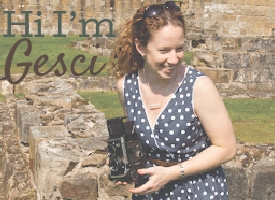Auschwitz-Birkenau is one of the most important sites in 20th century history. Both Paul and I knew it was a priority for our visit to the area, so we decided to go the first day. We hired a private guide for the three of us (Paul's sister, Caitlin, was along with us) and she was worth every zloty. I'll touch more on that in the 7 Tips. The sites overall are eerily peaceful, as most places of horror are after the events have ended. The grass is lush and the birds are joyful. As we walked around the camps and through the buildings, there were distinct moments that, realizing I was seeing the exact views, walls, and doors as the victims of the Nazi regime did, the stark reality of what happened here sunk in. The buildings we walked through, the belongings we saw, and the paths and roads we traversed will always stay with me and will always bring the tears to my eyes that are here now, as I write this.
To be frank, growing up in the United States, especially in my generation, we were and are quite spoiled. We have never been personally threatened with war and battles physically in our towns, we have never had enemy soldiers occupy our homes, and other than terrorist attacks (both international and domestic) we don't have any feasible clue what it's like to live in fear for our freedoms and desperation for our lives. We studied WWII and the Holocaust in school, it was never treated flippantly or with disrespect, and I even was able to visit the United States Holocaust Memorial Museum twice in high school. Both of my grandfathers fought in WWII. That said, it's very easy to (unconsciously and unintentionally) push aside the events that transpired during the 1930s-40s in Europe that led to and were involved in modern history's greatest atrocity: the genocide of the Holocaust. This all occurred so far away, and so long ago (at least to an American teenager), that it can be hard to remember that each of these victims was an individual- a teacher, a butcher, a daughter, an uncle, a friend, a school rival, a redhead, tall, brown eyed, etc.
To be frank, growing up in the United States, especially in my generation, we were and are quite spoiled. We have never been personally threatened with war and battles physically in our towns, we have never had enemy soldiers occupy our homes, and other than terrorist attacks (both international and domestic) we don't have any feasible clue what it's like to live in fear for our freedoms and desperation for our lives. We studied WWII and the Holocaust in school, it was never treated flippantly or with disrespect, and I even was able to visit the United States Holocaust Memorial Museum twice in high school. Both of my grandfathers fought in WWII. That said, it's very easy to (unconsciously and unintentionally) push aside the events that transpired during the 1930s-40s in Europe that led to and were involved in modern history's greatest atrocity: the genocide of the Holocaust. This all occurred so far away, and so long ago (at least to an American teenager), that it can be hard to remember that each of these victims was an individual- a teacher, a butcher, a daughter, an uncle, a friend, a school rival, a redhead, tall, brown eyed, etc.
Each of these victims was you. Each of these victims was me.
At Birkenau there is a room set up to display the photographs that were so treasured by the victims. Most of us, thinking back to the "house on fire" game, would save photographs- I would most certainly grab as many of my negative binders as I could carry. These particular portraits and snapshots serve a dual purpose, though; they are not just representative of the memories and cherished moments of the people who carried them, but of the subjects in them. We can assume that these photographs are predominately of family members, many of whom were also murdered during the Holocaust.
At Birkenau there is a room set up to display the photographs that were so treasured by the victims. Most of us, thinking back to the "house on fire" game, would save photographs- I would most certainly grab as many of my negative binders as I could carry. These particular portraits and snapshots serve a dual purpose, though; they are not just representative of the memories and cherished moments of the people who carried them, but of the subjects in them. We can assume that these photographs are predominately of family members, many of whom were also murdered during the Holocaust.
I found this portrait especially moving. I wondered (as I am wont to create back stories) if this young couple may have married during the segregation and persecution, and perhaps this was a portrait of them to commemorate such a celebratory life event, marred by their somber expressions and the Star of David armbands they wear.
There were several areas of images collected from one victim, or one family of victims, shown with a small biography of the people.
These show some happy, everyday family moments- camping, riding a bike, maybe first day of school.
These were the clothes given to the prisoners who were "lucky" enough to make it through registration. Underwear was scarce, and clothes were washed and disinfected once a month. As supplies grew short, prisoners were often given the poor quality garments collected from the suitcases, modified by a painted stripe down the back.
One hallway with mug-shot like pictures of the prisoners, usually showing name, date of internment, and date of death. Some also gave occupations and birth dates.

























No comments:
Post a Comment
Thanks so much for stopping by! I can't wait to read your comment!